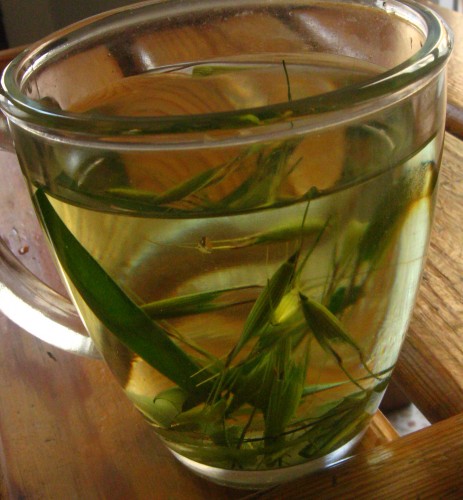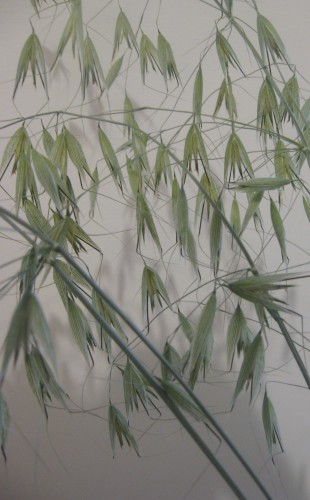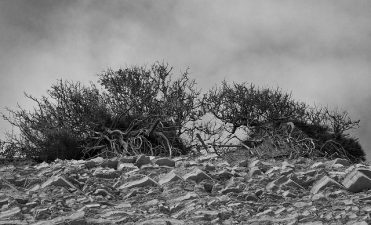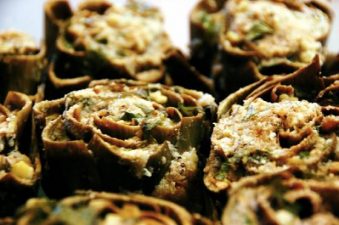 Calcium and mineral-rich oatstraw tea nourishes, soothes – and stimulates.
Calcium and mineral-rich oatstraw tea nourishes, soothes – and stimulates.
Wait – that’s supposed to be “sow your wild oats” – isn’t it?
It makes more sense to reap them. At this time of year in the Middle East, native Avena sterilis sends up its nodding seed heads in empty lots, fields, and neglected gardens everywhere. All you have to do is yank up a handful, stalk, leaves, seeds and all, and bring it home to make tea. The oat kernels hidden inside the bearded husk are tender and difficult to extract by hand, but the good news is, you can cut up an entire stalk (minus the root), take this oatstraw and brew a nourishing tea out of it.
How is oatstraw tea good for you? This home remedy is rich in calcium and the minerals and vitamins that nourish bones (helps prevent osteoporosis). It helps to stabilize blood sugar. Nowadays people know that when you eat the grain as oatmeal, you reduce cholesterol and improve blood circulation, but fewer take advantage of wild oats to make the infused tea, which does the same.
Herbalists often prescribe a soothing cup of oatstraw tea as a tonic to strengthen the nerves and help reduce tension and anxiety. It’s a good hot drink for jittery adolescents – or their stressed-out parents. Drunk before bedtime, it helps you sleep better. It is said to reduce headaches and menstrual cramps.
Oats combined with nettles, are known to be a sexual stimulant to men and an aid to lactation for nursing mothers. For these purposes, use one tablespoon of oatstraw and two teaspoons of nettles per two cups of boiling water.
Use this soothing plant to ease skin irritations. Simmer a good handful of oatstraw in a liter of water for twenty minutes. Strain the tea and add it to your medicinal bath. Or put oatstraw into a clean nylon sock and let it steep in the hot water while you bathe. For children with chicken pox, an oatstraw bath is one of the kindest things you can do.
How do you use oatstraw? Pick it now, while it’s still green and tender. A bagful will keep you going for a long time. Cut off any dirty parts near the root. One long green stalk is enough for two cups of infused tea. Cut it up with scissors, put the pieces into a cup, and pour two cups of boiling water over it. Allow the tea to infuse for four hours. Even better, overnight. Strain and drink, either gently re-heated or cold. It is mild-tasting and good; very slightly sweet.
Oatstraw dries quickly, which makes it easy to store. Just put the stalks in a jar or spread them out on a cloth and allow them to dry, in the shade. When the stalks and heads are a light golden color and rustle dryly, you can store them in a glass jar. It will keep a year.
To brew tea from dry oatstraw, take a tablespoon of the chopped material and pour two cups of boiling water over it. Allow it to steep four hours to overnight, as with the green stuff.
Dosage is three cups of oatstraw tea a day, for any purpose.
If you keep birds, try poking a stalk, either green or dry, through the bars of the cage. Budgies, especially, love them.
And children love to gather them. If you’re not going to be planting a tree for Tu B’Shvat, you might take the little ones out to discover the wild oats. It’s free, green food and medicine. Just remember, when you forage it, to take only what you think you’ll need and no more.

Other springtime posts you’ll enjoy:




All good points, DL. In Israel, from where I write, avena sterilis is the local wild oat, and it is native. One sentence I always include in any foraging post is this one’s last: take only what you need, and no more.
These grasses (Avena sp.) are invasive non-native weeds that many land restoration employees work hard to try and get rid of/control. If you’ve found a use for them that promotes people coming out and doing some weeding then all the better. Take em all, don’t leave any seeds behind and relax knowing that you might be doing good for yourself and your local habitat. This recipe stands as an exception for me, as I generally don’t support much foraging. Anyone engaging in this should be aware not only of a plant’s nutritional value, have a strong ability to identify it, but also know whether the plant is endangered or not.In the case of wild oats in the US, I say take all you want and then take some more. Just be aware that foraging for some native species can be damaging to their chances of surviving for the future. I recommend looking up what plants are native to your area and try to avoid harvesting, as many of them are disappearing by being pushed out by invasive exotic species like the wild oat grasses. Cheers 🙂
Jessica and Kaylee,
Oat straw baths won’t take away the pock marks, but soothes the horrible itching of chicken pox while the disease is active. To shrink and heal pock marks, pierce a Vitamin E capsule and smear a little of the oil on each pock mark, several times a day. It takes a while to work, and if the marks aren’t fresh it will take longer. But I would do it for at least 6 months, if not a year, before giving up.
On the other hand, I hardly know anyone who doesn’t carry a few pock marks on their skin…doesn’t seem to deter famous actors or actresses, either.
Chicken pox is one hell of a nasty disease, it ruined my flawless skin a couple of years ago..,.
Chicken pox is one hell of a nasty disease, it ruined my flawless skin a couple of years ago.–‘
I heard about wild oats and nettles as a treatment for low testosterone levels (actually, just low circulating levels, as most men don't actually have low levels of testosterone) in an audio presentation by world-renown herbalist Jon Barron: http://www.jonbarron.org/audio/audio_series.php (highly recommended free series of lectures are on his site!)It's quite interesting about the other good uses for wild green oats, such as soothing the skin and treating chicken pox. Nature really provides all we need!
This is completely new to me! Next time I take a walk I will look for these.
This is completely new to me! Next time I take a walk I will look for these.